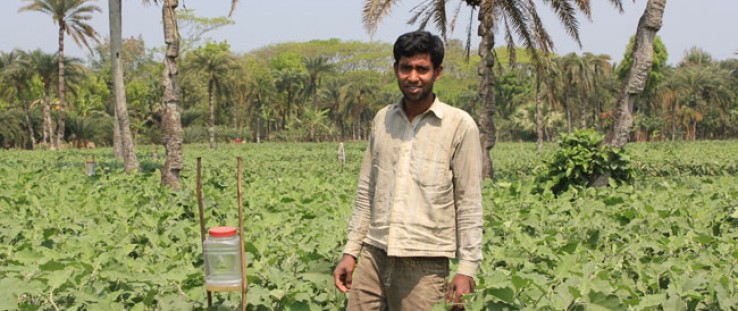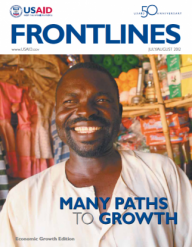 credit: Bushra Rahman, USAID PRICE Project
credit: Bushra Rahman, USAID PRICE Project
 credit: Bushra Rahman, USAID PRICE Project
credit: Bushra Rahman, USAID PRICE Project
Mohammed Azad stands next to a pheromone trap, which lures insects and decreases the need for pesticides.
Mohammed Azad has been involved with eggplant production since 1998, when he joined his father in vegetable farming after finishing eighth grade near Hurgati, Jessore, in southwestern Bangladesh.
In 2006, the then-22-year-old Azad took over management of his father’s farm, growing eggplant and other seasonal vegetables on his quarter-hectare plot (about half the size of an American football field). Eggplant is one of the crops most prized by smallholder farmers in Bangladesh, and it is the second most commonly grown vegetable in the south, where demand is high.
But Azad’s crops—like those of many Bangladeshi farmers—suffered from pest attacks, poor yields and high production costs. Each year, around 30 percent of his produce was ruined.
With two families to support—his own wife and child, as well as his parents and siblings—Azad nearly gave up on the lucrative but fickle cash crop. But with USAID’s help, he was able to take advantage of several agricultural technology initiatives and turn his fortunes around.
Starting in 2008, the USAID project began supporting training for 2,050 eggplant farmers on modern growing practices. The project organized farmer field schools, which have an educational curriculum and extension approach that is popular worldwide. Such “schools,” which are essentially regular training sessions, use a group, hands-on approach to help farmers make decisions, solve problems and learn new techniques. Demonstration plots have showcased best practices.
“Field days” have also helped growers identify pests and diseases, implement cost-effective control measures, learn to assess the maturity of eggplant crops, and improve harvesting methods to reduce produce spoilage. The USAID project, which ends next year, has also supported improved market linkages for participating farmers.
New Technologies, New Techniques
Since Azad had no clear idea about the type of pest affecting his eggplant field, he would randomly apply—and often overuse—pesticides, increasing his costs without solving the problem. Since he didn’t know how to manage seedlings in a nursery, he rarely received the good yields and prices that could result from high-quality produce—a common problem in the nation of 160 million people, around half of whom are farmers.
In November 2010, Azad attended a two-day training course on growing eggplant with improved technology. He learned practical, modern, yet easily applicable care for eggplant crops, including the advantages of low-cost compost fertilizer, biological pest control methods such as pheromone traps, and irrigation best practices.
“I have been involved with eggplant cultivation for the last 14 years. I never knew that eggplant crops need nursing. I had no idea about the proper way to irrigate, manage pests, how to use the right amount of fertilizer in a certain area of land, or use compost fertilizer for better production,” Azad said.
To address the ongoing problem of pest attacks, the project promoted Integrated Pest Management, a time-tested, cost-effective and environmentally friendly approach to pest management that uses a mix of mechanical, biological and chemical control methods.
Around 300 eggplant farmers who trained through the program in Hurgati reported spending a total of about $77,000 for pest management prior to adopting the new practices. After using biological control agents such as pheromone traps and minimizing use of pesticides, farmers spent just $25,000 for the same area cropped to eggplant, and the percentage of crops lost to pests was reduced from between 12 percent and 15 percent to about 2.5 percent.
With higher-quality produce, Azad could now consider new markets. Previously, he sold his eggplant to middlemen at a comparatively lower price because of the crop’s low quality and his lack of knowledge about pricing in local and regional markets.
The USAID project helped Azad build market connections, and now he and his fellow neighborhood farmers aggregate their higher-quality produce and take it to two wholesalers in a regional market in Manirampur. Thus, they get a premium price for a reliable, high-quality supply of produce. Through linkages established as part of the program, Azad also was able, for the first time, to supply eggplant to other major markets such as Dhaka and Khulna.
An Economy Built on Agriculture
In Bangladesh, where most people live in rural areas, agriculture employs around half the labor force and accounts for a fifth of the country’s GDP.
And smallholders are not only the driving force behind the overall growth in the agriculture sector, but are also key to the country’s efforts to counter the second-highest undernutrition rates in South Asia.
Nationally, 30 percent of women are underweight, and 41 percent of children under age 5 are chronically undernourished or “stunted.” Because chronic undernutrition is higher in rural areas, children there are less likely to be physically and mentally developed than their urban peers. The condition is aggravated by lack of food variety in meals; for example, about 80 percent of dietary energy comes from cereals (75 percent from rice alone). Smallholder farms can counteract this by contributing to more diversity in the diet.
The U.S. Feed the Future strategy in Bangladesh, focused in the southern part of the country where Hurgati is located, aims to increase the productivity of about 1 million small-farm households. Through this U.S. Government flagship food security initiative, rice yields are expected to increase by 20 percent over the next four years, freeing up land for more diversified production, including fruits, vegetables, beans and fish.
Feeding the Rural Economy
Recognizing that it takes time to adopt new technology, the USAID program provided refresher training in 2011 before the eggplant production season started. Azad attended the day-long session, and that year he put his learning into practice, applying the new techniques at every step, from seed sowing in the nursery to harvesting.
The effect was tremendous. Azad’s profits increased along with his production. In 2010, he made a profit of $120 by selling 4,000 kilograms of eggplant, and in 2011 he made a profit of $490 by selling over 13,500 kilograms of eggplant, all produced on the same plot of land. As the market develops further, Azad’s profits should increase as the quality of his crop improves.
His additional profits have enabled him to buy more land and to take out a long-term lease for additional land to supplement his production. He built his own house and bought some cattle. He can now better support his own family, as well as his parents and siblings.
“I am truly grateful … as it has now changed the level of my living. I came to know many things about safe eggplant production, and now I know how to produce more eggplant fruit with less investment,” said Azad.
This year, Azad took the logical next step in his eggplant odyssey. He began acting as an agent of change in his neighborhood, encouraging other eggplant growers and helping guide them to use better technology—all lessons he learned from the USAID-supported training.









Comment
Make a general inquiry or suggest an improvement.